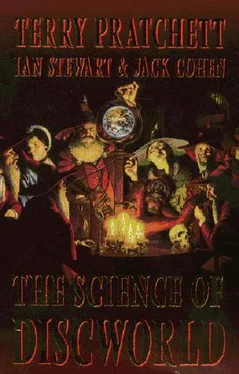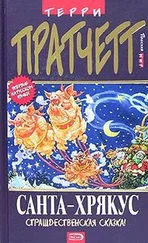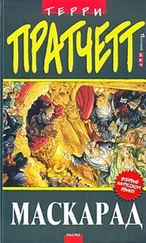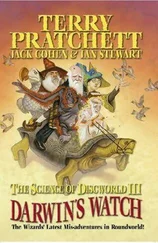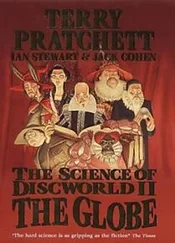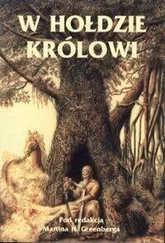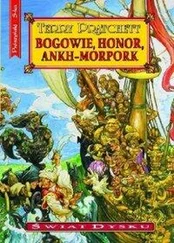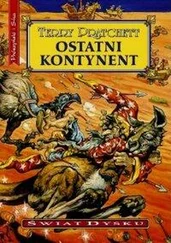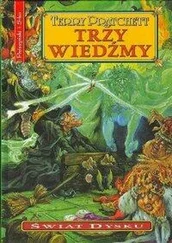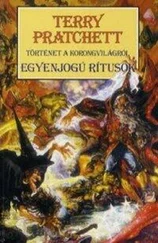Terry Pratchett - Science of Discworld
Здесь есть возможность читать онлайн «Terry Pratchett - Science of Discworld» весь текст электронной книги совершенно бесплатно (целиком полную версию без сокращений). В некоторых случаях можно слушать аудио, скачать через торрент в формате fb2 и присутствует краткое содержание. Жанр: Фантастика и фэнтези, на английском языке. Описание произведения, (предисловие) а так же отзывы посетителей доступны на портале библиотеки ЛибКат.
- Название:Science of Discworld
- Автор:
- Жанр:
- Год:неизвестен
- ISBN:нет данных
- Рейтинг книги:4 / 5. Голосов: 1
-
Избранное:Добавить в избранное
- Отзывы:
-
Ваша оценка:
- 80
- 1
- 2
- 3
- 4
- 5
Science of Discworld: краткое содержание, описание и аннотация
Предлагаем к чтению аннотацию, описание, краткое содержание или предисловие (зависит от того, что написал сам автор книги «Science of Discworld»). Если вы не нашли необходимую информацию о книге — напишите в комментариях, мы постараемся отыскать её.
Science of Discworld — читать онлайн бесплатно полную книгу (весь текст) целиком
Ниже представлен текст книги, разбитый по страницам. Система сохранения места последней прочитанной страницы, позволяет с удобством читать онлайн бесплатно книгу «Science of Discworld», без необходимости каждый раз заново искать на чём Вы остановились. Поставьте закладку, и сможете в любой момент перейти на страницу, на которой закончили чтение.
Интервал:
Закладка:
Empedocles's theory was a distinct advance on its predecessors. Thales, Heraclitus, and Anaximenes all agreed that everything was made from just one basic 'principle', or element, but they disagreed completely about what it was. Thales reckoned it was water, Heraclitus preferred fire, and Anaximenes was willing to bet the farm on air. Empedocles was a wishy-washy synthesist who thought everyone had a valid point of view: if alive today he would definitely wear a bad tie.
The one good idea that emerged from all this was that 'elementary' constituents of matter should be characterized by having simple, reliable properties. Earth was dirty, air was invisible, fire burned, and water was wet.
Aside from the superior horse collar, the medieval period did act as a breeding ground for what eventually turned into chemistry. For centuries the nascent science known as alchemy had flourished; people had discovered that some strange things happen when you mix substances together and heat them, or pour acid over them, or dissolve them in water and wait. You could get funny smells, bangs, bubbles, and liquids that changed colour. Whatever the universe was made of, you could clearly convert some of it into something else if you knew the right trick. Maybe a better word is 'spell', for alchemy was akin to magic, lots of special recipes and rituals, many of which actually worked, but no theory about how it all fitted together. The big goals of alchemy were spells, recipes, for things like the Elixir of Life, which would make you live forever, and How to Turn Lead Into Gold, which would give you lots of money to finance your immortal lifestyle. Towards the end of the Middle Ages, alchemists had been messing about for so long that they got quite good at it, and they started to notice things that didn't fit the Greeks' theory of four elements. So they introduced extra ones, like salt and sulphur, because these substances also had simple, reliable properties, different from being dirty, invisible, burning, or wet. Sulphur, for example, was combustible (though not actually hot, you understand) and salt was incombustible.
By 1661 Robert Boyle had sorted out two important distinctions, putting them into his book The Sceptical Chymist. The first distinction was between a chemical compound and a mixture. A mixture is just different things, well, mixed up. A compound is all the same stuff, but whatever that stuff is, it can be persuaded to come apart into components that are other kinds of stuff- provided you heat it, pour acid on it, or find some other effective treatment. What you can't do is sort through it and find a different bit; for a mixture you can, although you might need very good eyesight and tiny fingers. The second distinction was between compounds and elements. An element really is one kind of stuff: you can't separate it into different components.
Sulphur is an element. Salt, we now know, is a compound made by combining (not just mixing) the two elements sodium (a soft, inflammable metal) and chlorine (a toxic gas). Water is a compound, made from hydrogen and oxygen (both gases). Air is a mixture, containing various gases such as oxygen (an element), nitrogen (also an element), and carbon dioxide (a combination of carbon and oxygen). Earth is a very complicated mixture and the mix varies from place to place. Fire isn't a substance at all, but a process involving hot gases.
It took a while to sort all this out, but by 1789 Antoine Lavoisier had come up with a list of 33 elements that were a reasonable selection of the ones we use today. He made a few understandable mistakes, and he included both light and heat as elements, but his approach was systematic and careful. Today we know of 112 distinct elements. A few of these are artificially produced, and several of those have existed on Earth only for the tiniest fraction of a second, but most elements on the list can be dug up, extracted from the sea or separated from the air around us. And apart from a few more artificially produced elements that it might just be possible to make in future, today's list is almost certainly complete.
It took another while for us to get that far. The art of alchemy slowly gave way to the science of chemistry. Gradually the list of accepted elements grew; occasionally it shrunk when people realized that a previously supposed element was actually a compound, such as Lavoisier's lime, now known to be made from the elements calcium and oxygen. The one thing that didn't change was the only thing the Greeks had got right: each element was a unique individual with its own characteristic properties. Density; whether it was solid, liquid, or gas at room temperature and normal atmospheric pressure; melting point if it was solid, for each element, these quantities had definite, unvarying values. It is the same on Discworld, with its to our eyes bizarre elements such as chelonium (for making world-bearing turtles), elephantigen (ditto elephants), and narrativium, a hugely important 'element' not just for Discworld, but for understanding our own world too. The characteristic feature of narrativium is that it makes stories hang together. The human mind loves a good dose of narrativium.
In this universe, we began to understand why elements were unique individuals, and what distinguished them from compounds. Again the glimmerings of the right idea go back to the Greeks, with Democritus' suggestion that all matter is made from tiny indivisible particles, which he called atoms (Greek for 'not divisible')- It is unclear whether anybody, even Democritus, actually believed this in Greek times, it may just have been a clever debating point. Boyle revived the idea, suggesting that each element corresponds to a single kind of atom, whereas compounds are combinations of different kinds of atoms. So the element oxygen is made from oxygen atoms and nothing else, the element hydrogen is made from hydrogen atoms and nothing else, but the compound water is not made from water atoms and nothing else, it is made from atoms of hydrogen and atoms of oxygen.
By 1807, one of the most significant steps in the development of both chemistry and physics had taken place. The Englishman John Dalton had found a way to bring a degree of order to the different atoms that made up the elements, and to transfer some of that order to compounds too. His predecessors had noticed that when elements combine together to form compounds, they do so in simple and characteristic proportions. So much oxygen plus so much hydrogen makes so much water, and the proportions by weight of oxygen and hydrogen are always the same. Moreover, those proportions all fit together nicely if you look at other compounds involving hydrogen and other compounds involving oxygen.
Dalton realized that all this would make perfect sense if each atom of hydrogen had a fixed weight, each atom of oxygen had a fixed weight, and the weight of an oxygen atom was 16 times that of hydrogen. The evidence for this theory had to be indirect, because an atom is far too tiny for anyone to be able to weigh one, but it was extensive and compelling. And so the theory of 'atomic weight' arrived on the scene, and it let chemists list the elements in order of atomic weight.
That list begins like this (modern values for atomic weights in brackets): Hydrogen (1.00794), Helium (4.00260), Lithium (6.941), Beryllium (9.01218), Boron (10.82), Carbon (12.011), Nitrogen (14.0067), Oxygen (15.9994), Fluorine (18.998403), Neon (20.179), Sodium (22.98977). A striking feature is that the atomic weight is nearly always close to a whole number, the first exception being chlorine at 35.453. All a bit puzzling, but it was an excellent start because now people could look for other patterns and relate them to atomic weights. However, looking for patterns proved easier than finding any. The list of elements was unstructured, almost random in its properties. Mercury, the only element known to be liquid at room temperature, was a metal. (Later just one further liquid was added to the list: bromine.) There were lots of other metals like iron, copper, silver, gold, zinc, tin, each a solid and each quite different from the others; sulphur and carbon were solid but not metallic; quite a few elements were gases. So unstructured did the list of elements seem that when a few mavericks, Johann Dobereiner, Alexandre-Emile Beguyrer de Chancourtois, John Newlands, suggested there might be some kind of order dimly visible amid the muddle and mess, they were howled down.
Читать дальшеИнтервал:
Закладка:
Похожие книги на «Science of Discworld»
Представляем Вашему вниманию похожие книги на «Science of Discworld» списком для выбора. Мы отобрали схожую по названию и смыслу литературу в надежде предоставить читателям больше вариантов отыскать новые, интересные, ещё непрочитанные произведения.
Обсуждение, отзывы о книге «Science of Discworld» и просто собственные мнения читателей. Оставьте ваши комментарии, напишите, что Вы думаете о произведении, его смысле или главных героях. Укажите что конкретно понравилось, а что нет, и почему Вы так считаете.
